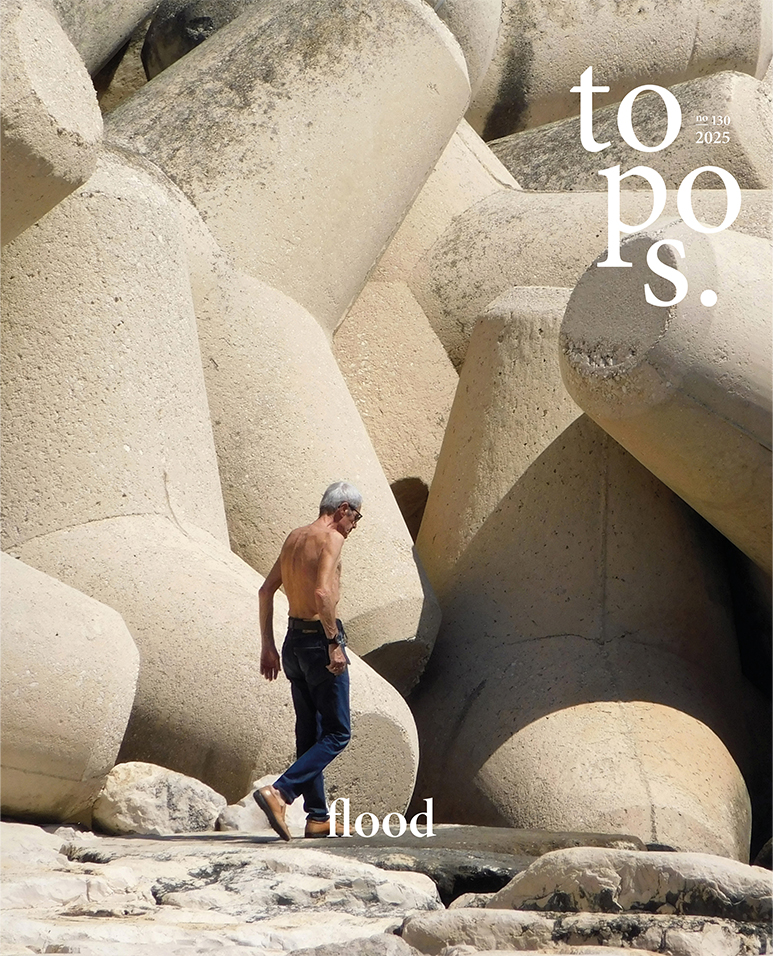

topos
THE INTERNATIONAL REVIEW OF LANDSCAPE ARCHITECTURE AND URBAN DESIGN.
topos - The International Review of Landscape Architecture and Urban Design - focuses on landscape architecture as well as increasingly on architecture and urban planning. It sees itself as an interdisciplinary think tank aimed at addressing the challenges urban areas will face in future. The professional magazine strives to inspire planning practitioners, urban experts and professionals who shape the cities of tomorrow. Every issue of the periodical, that is published quarterly, is dedicated to a different topic and deals with a broad array of projects and planning work in countries all over the world.
LATEST ISSUE
TOPOS 132: AI Pioneers
Artificial intelligence is no longer a promise of the future – it has already become part of the systems that run our cities. It drafts emails, designs buildings, steers traffic, and powers civic chatbots. It answers before we finish asking. Sometimes it lies, sometimes it hallucinates – and yet it always responds.This issue of topos does not celebrate AI, nor does it dismiss it. Instead, it takes the machine seriously. For planners, architects and urbanists, AI is now embedded in the very fabric of urban life – silently shaping infrastructures, simulations, and decisions. But what values are hidden in its code? Who defines its assumptions? And what happens when the model becomes more legible than the street itself?We explore the promises and perils of a technology that reproduces the past more than it imagines the future, that optimises for efficiency but risks narrowing democracy. From hackers and ethicists to urban designers and policy-makers, this issue uncovers the ethical, political and practical questions behind AI’s urban influence.AI Pioneers asks not what AI can do for cities, but what it means when urbanism itself becomes a function of AI.
Get a free preview of our current issue – enjoy the read.
TOPICS OF TOPOS
URBAN DESIGN & LANDSCAPE ARCHITECTURE
When it comes to urban planning and urban design it’s all about the cities we live in, the city as a polis, the city as a place to encounter, to work, to move, to recreate. It is about on how we design and shape the physical appearance of urban realms in future. So, how shall we plan and design the built environment in a sustainable way? How do we create green spaces and livable, human centered public spaces? How do we ensure that the city is a place of diversity and equality? What measures do we as planners take to mitigate the effects of climate change in the cities all over the world? And: how do we adapt to climate change and to stressors and risks?
ARCHITECTURE & URBAN PLANNING
Architecture affects society as a whole and has vital impacts on the individual person, too. Architects shape the places we live in. So, what is the role of architecture when it comes to shaping future cities and facing urban challenges? How and in what surroundings do we want to live? What is the social role of architecture? How to ensure a sustainable building process? What kind of material is future-proof and sustainable? What skills do planners need to create sustainable, human-centered architecture? What role does urban green play in the field of architecture? And: What happens with the spaces between the buildings, the spaces we share as urbanites?
URBAN GOVERNANCE & SOCIETY
Who creates the cities of today and tomorrow? It should be the people. When it comes to developing urban areas, it is crucial to include all necessary stakeholders into the planning process, not only the politics. So, how to manage, plan and initiate city development, design and plan urban realms? Urban governance involves a constant process of negotiation and compromising – and it should be established in the most possible transparent way. It is a matter of balancing out legal requirements, financial resources and the expectations and needs of the citizenship. How to design a city for all, a city that includes the marginalized? How to ensure green spaces for all citizens?
MOBILITY / TRANSPORTATION
Cities all over the world need intelligent mobility and transportation concepts to stay livable places to their inhabitants. How to design urban and rural realms that come face to face with a new kind of mobility in an increasingly urbanised, digitalised and exploited world. What are the challenges and trends when it comes to urban mobility and the sustainable and efficient transportation of goods? How to transform cityscapes and landscapes to be open to both, slow and fast traffic?
TECH
By what ideas, methods, projects and research approaches do we address major urban issues such as climate change, air and environmental pollution, digitalisation, migration, urbanisation, resource and energy consumption, land consumption and poverty? What strategies of resilience can be established in urban development, urban design, urban planning, infrastructure planning and landscape architecture? What design solutions are at our disposal to make our cities more resilient and more future-proof? How do we plan and design greener, healthier, human-centered, sustainable and resilient urban spaces and architecture?
LAST ISSUES


TOPOS 131: 15-minute city
The concept of the 15-minute city is causing a stir in urban planning worldwide. It promises liveable, walkable neighbourhoods in which everything important - from schools and healthcare to workplaces - can be reached within 15 minutes. Paris, Barcelona and Melbourne have already adopted this model. But can it really improve everyday life, reduce emissions and strengthen the sense of community? In view of the World Bank's forecast that almost 70 per cent of humanity will live in cities by 2050, the question arises: is the 15-minute city more than just an ideal?
Read more...


TOPOS 130: flood
topos 130 is dedicated to the topic of FLOOD. Water gives us a lot, but it also takes a lot from us. Violently or insidiously. Floods, high water, inundations - these are terrible natural disasters that are occurring more and more frequently. Climate change is reflected in them. Cities like Valencia are experiencing nightmares, while in India and Ghana rainwater management is becoming a problem. What is the situation in New Orleans and what is Copenhagen doing? In a series of images from the organisation climate central, we show what cities like Washington will look like in 100 years if the temperature rises by three degrees. Read more...


TOPOS 129: zero waste
The latest issue of topos 129, the last in 2024, highlights the growing importance of the zero-waste concept and how it is being pursued in cities around the world. The global increase in waste production is prompting cities and our actions to rethink how we deal with it. The vision of zero-waste cities is idealistic, but it is inspiring innovation and cultural change, as examples from New York and Kiel show. Companies like Patagonia and activists like Robin Greenfield are presented as role models for sustainable consumption, while international funding from organisations like the World Bank is highlighted as crucial to global solutions. Read more...

